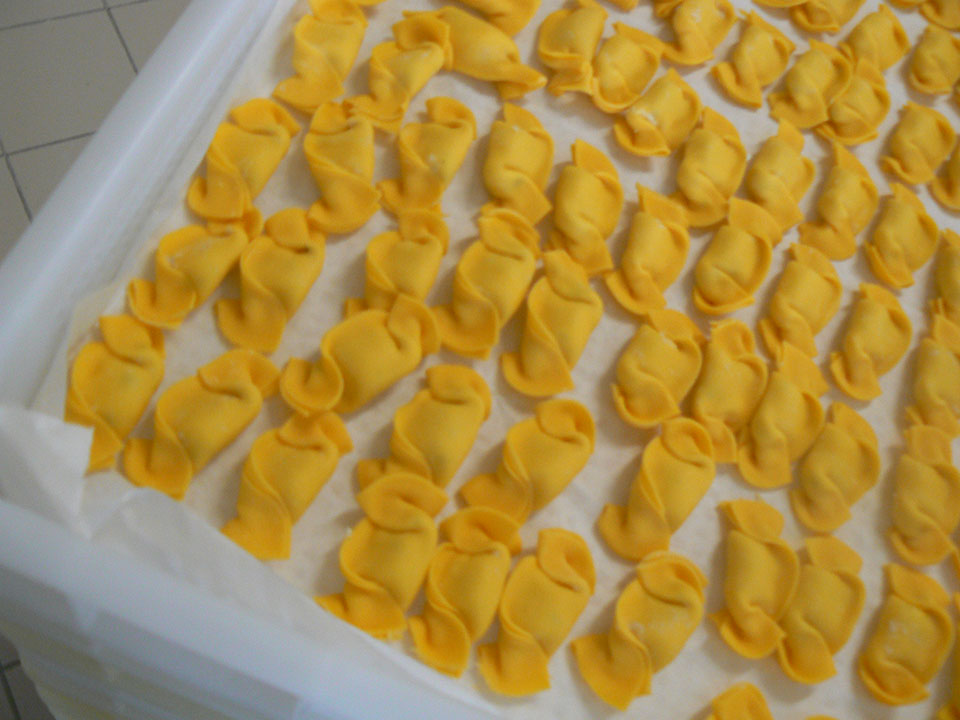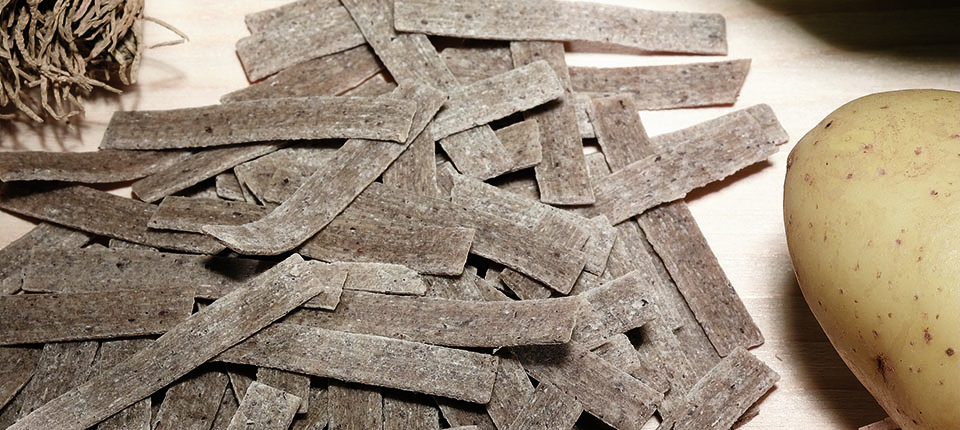
Effect of raw materials and pasta making process on the colour of pasta
16 April 2012Together with the behaviour during cooking, appearance is one of the most important properties for defining the quality of pasta.
This article tries to understand the factors which have an effect on these. Specifically, we are talking of raw materials and some of the variables in the production process correlated to the colour of pasta
by Eleonora Carini
Pasta, being a food matrix consisting of very few ingredients – semolina and water in its basic preparation – and having a technologically tried and tested production process, is generally considered to be a “simple” food. The presence of very few ingredients must however not be misleading, since the water and the main constituents of the semolina (starch and gluten proteins) interact at different levels, and the modifications they undergo during the entire production process make the pasta a complex food matrix.
The quality of the final product, pasta, is influenced by the properties of the raw materials as well as the process variables. We often hear of quality of pasta, but what does “quality of pasta” mean? Is there a “universal” definition of quality? Are there specific requisites to obtain a good quality pasta? No, there are no recognised universally and scientifically objective parameters for defining the quality of pasta.
The consumer judges the quality of the pasta very subjectively; the sensorial assessment is mainly aimed at the (cooked) pasta and is influenced by the cultural background and personal experience. For the Italian consumer, for example, a “good quality pasta” must have certain definite features such as a yellow colour, the water must remain clear after cooking and the pasta must be firm to the bite i.e. “al dente”.
The “al dente” feature as well as the yellow colour (in some cases the result of adding egg to the preparation) are features required in Italy but, in other countries (Argentina, countries of Asia, etc.) softer/more fragile and “whiter” pasta is preferred. Pasta consumption also includes a large variety of products and types of consumption. Pasta can be cooked in different ways (for example cooked with lots of water or in an oven with condiments, such as lasagne) and each type of use requires certain features of consistency and shouldn’t overcook.
Nevertheless, on the basis of the final judgment of the consumer and the scientific community, it is agreed, above all else, that the appearance of the pasta and its behavior during cooking are the most important properties which define its quality.
An attempt will be made here to understand the factors influencing the appearance of the pasta; specifically, the influence of the raw materials and the process variables on the definition of the final colour of the pasta will be explained.
The appearance of the pasta includes various features which influence the consumer’s perception. A uniform colour contributes to the perception of pasta as an excellent quality product. A uniform colour implies the absence of stripes and white marks (which derive from a non uniform hydration, mixing and shaping of the semolina/dough and by the presence of integumental residues), and the absence of cracks/fissures. Another peculiar feature characterizing the appearance is the “consistency” of the surface which must appear uniform; this feature can be obtained when the drying phase and storage conditions are correct.
A yellow colour is generally perceived as a colour due to a good quality pasta and is therefore a feature desired and required by the consumer (purely Italian). Therefore, the presence of components which contribute to a reddish and/or brownish colour is to be considered as undesirable because it reduces the acceptability by the consumer.
As was mentioned earlier, the final colour of the pasta is influenced by various factors which depend mainly on the features of the raw materials (semolina and other ingredients, if present) and by the process parameters, specifically by certain steps considered as key for the typical temperatures exercised.
The carotenoids content [mainly xanthophylls (lutein) and carotene] of the semolina is one of the prerogatives for the purpose of obtaining an excellent colour of the pasta. The carotenoids are coloured pigments, i.e. molecules naturally present in plants which give a colour ranging from pale yellow to orange to bright red. The carotenoids content is linked to the type of wheat cultivar, genotype, wheat storage conditions and how the milling is done. The content of carotenoids varies between the different fractions of the grain of wheat: in the germ there are larger quantities as compared to the endosperm and bran fractions. Depending on the milling extraction rate, part of the carotenoids may be eliminated during the process; a correct milling operation is therefore desirable in order to preserve a certain quantity. Preservation of the carotenoids is strictly correlated to the content and to the activities of certain enzymes, such as lipoxygenase (to be found in the germ), and peroxidase and polyphenol oxidase (to be found in the bran layers). These enzymes, also naturally present in the grain, are considered to be responsible for degradation of carotenoids. Since these are distributed differently in the various layers forming the grain, the milling extraction rate can influence their content and thereby, indirectly, also the content of carotenoids. Various scientific studies report that high milling extraction rates were associated with an increase in the content of these enzymes. It is for this reason too that it is advisable to have extractions rates that are not too high.
We shall now consider the pasta making process variables which have most influence on the colour.
Mixing-kneading and shaping are the first phases in pasta making, and allow the transformation of raw materials semolina and water into pasta. These phases are not usually considered as having a primary role in determining the final colour of the pasta, however, it is necessary to take into consideration that the temperature and pH conditions characteristic of these phases (40-50°C and slightly acidic pH) are found to be optimum for the activity of certain enzymes (?-amylase). These enzymes cause the breakage (depolymerization) of the starch molecules leading to the formation of simple sugars. The sugars react (in the so-called “Maillard reactions”) with the amine residues present, due to the effect of high temperatures, forming undesirable coloured compounds. It is not only the temperature which acts as the promoting factor, there is another parameter, i.e. time. To try to reduce the formation of high quantities of reducer sugars and thereby the formation of coloured compounds, the mixing, kneading and extrusion phases must be completed in the shortest times (consistent with the features of the raw materials and the final product to be obtained). During the extrusion phase the pressure exerted on the dough can partly lead to inactivation of the enzymes ?-amylase and therefore act as a “buffer”. There are really very few scientific studies concerning the effects of the different mixing and shaping methods on the colour of pasta, and those present were conducted only on fresh pasta. According to what has been mentioned in these studies, the operating conditions in the initial phases of the process can influence the final colour of the pasta (fresh). It was, in fact, observed that the colour of fresh pasta obtained by lamination (or rolling), with (Zardetto and Dalla Rosa, 2006) and without (Carini, Vittadini, Curti e Antoniazzi, 2009) egg, is significantly different from that of extruded pasta. Specifically, laminated fresh pasta without egg is found to be yellower than extruded pasta. The different features observed in pasta were attributed to the intrinsic differences between the two processes i.e. at different stress conditions in terms of temperature and pressure to which the dough is subjected. An even more marked yellow colour can be obtained by lamination in vacuum conditions.
Proceeding along the process, after the shaping process, the pasta is subjected to drying, which influences the final colour to a greater extent than the other phases. In this phase, the high temperatures promote the above-mentioned Maillard reactions which lead to the formation of red/brown components. The higher the temperature, the more the undesirable compounds that are formed, and all this is amplified if the product is exposed to high temperatures for longer times. The application of drying cycles at high temperatures by pasta makers in the last few decades has reduced the process times, but also inevitably favoured the formation of undesirable coloured molecules. The lower furosine contents (one of the various compounds of the Maillard reactions) were found in pasta produced in more “moderate” milling, kneading, shaping and drying conditions tested. The highest furosine contents were found in pasta produced with milling cycles with high extraction rates and dried at temperatures higher than 75°C; this pasta is therefore to be considered as probably altered in their colouring.
However, in the production of fresh pasta, where the drying phase is not present, it is the pasteurisation phase that can have a role on the colour variation. It was reported, on the basis of the results of a study conducted in 2006 by Zardetto and Dalla Rosa, that pasteurisation treatment at 99 °C (± 1° C) for 3 minutes on samples of extruded and laminated fresh egg pasta can cause a colour change.

